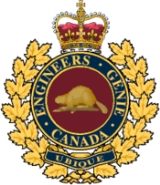
2 Combat Engineer Regiment
Encyclopedia
2 Combat Engineer Regiment is a regiment
of the Canadian Military Engineers
. It is located at CFB Petawawa
, and is part of 2 Canadian Mechanized Brigade Group
. 2 CER was redesignated from 1 Field Engineer Squadron in 1977.
It currently consists of 23 Field Squadron, 24 Field Squadron, 25 Support Squadron and 28 Administration Squadron.
One of the first tasks given to the Canadian engineers after the declaration of World War I was the construction of the Valcartier training site in Quebec. At its peak, 30,000 men were stationed there before the 1st Canadian Division was deployed.
When the 1st Canadian Division arrived in Belgium, they were accompanied by the Canadian Engineer Corps. These troops were responsible for the construction of defences, sanitation systems, water supplies, bridging, and assisting with trench raids.
The engineers, known as Sappers, were also tasked with digging tunnels underneath enemy trenches and planting explosives to destroy the trenches. These tunnels were strategic in winning the Battle of Vimy Ridge.
Canadian engineers spent the early phases of World War II building camps and bases, both in Canada and abroad. Eventually, they received assault training and participated in field exercises so as to join infantry divisions as they worked through occupied Europe. The majority of their work consisted of constructing bailey bridges, clearing mines and booby traps and building communication networks and field defences in Northwestern Europe and throughout Italy.
After the Canadian Forces unified in 1968, the Royal Canadian Engineers, Royal Canadian Navy Civil Engineers and the Royal Canadian Air Force Construction Division were amalgamated. The new branch went under the name Royal Canadian Engineers until 1973 when they were renamed the Canadian Military Engineers.
2 CER is part of this history of Canadian military engineers. It provides combat engineering support to 2 CMBG.
Regiment
A regiment is a major tactical military unit, composed of variable numbers of batteries, squadrons or battalions, commanded by a colonel or lieutenant colonel...
of the Canadian Military Engineers
Canadian Military Engineers
The Canadian Military Engineers is the military engineer branch of the Canadian Forces.-Mission:The mission of the Canadian Military Engineers is to contribute to the survival, mobility, and combat effectiveness of the Canadian Forces...
. It is located at CFB Petawawa
CFB Petawawa
Canadian Forces Base Petawawa, commonly referred to as CFB Petawawa, or simply "Pet", is a Canadian Forces Base located in Petawawa, Ontario. It is operated as an army base by Canadian Forces Land Force Command.-Base facts:...
, and is part of 2 Canadian Mechanized Brigade Group
2 Canadian Mechanized Brigade Group
2 Canadian Mechanized Brigade Group is a Canadian Forces brigade group that is part of Land Forces Central Area of the Canadian army. It is currently based in CFB Petawawa...
. 2 CER was redesignated from 1 Field Engineer Squadron in 1977.
It currently consists of 23 Field Squadron, 24 Field Squadron, 25 Support Squadron and 28 Administration Squadron.
Unit History
In 1903, following the Boer War, the Royal Canadian Engineers were founded as the basis for the permanent military engineers and the Canadian Engineer Corps was created as a militia unit.One of the first tasks given to the Canadian engineers after the declaration of World War I was the construction of the Valcartier training site in Quebec. At its peak, 30,000 men were stationed there before the 1st Canadian Division was deployed.
When the 1st Canadian Division arrived in Belgium, they were accompanied by the Canadian Engineer Corps. These troops were responsible for the construction of defences, sanitation systems, water supplies, bridging, and assisting with trench raids.
The engineers, known as Sappers, were also tasked with digging tunnels underneath enemy trenches and planting explosives to destroy the trenches. These tunnels were strategic in winning the Battle of Vimy Ridge.
Canadian engineers spent the early phases of World War II building camps and bases, both in Canada and abroad. Eventually, they received assault training and participated in field exercises so as to join infantry divisions as they worked through occupied Europe. The majority of their work consisted of constructing bailey bridges, clearing mines and booby traps and building communication networks and field defences in Northwestern Europe and throughout Italy.
After the Canadian Forces unified in 1968, the Royal Canadian Engineers, Royal Canadian Navy Civil Engineers and the Royal Canadian Air Force Construction Division were amalgamated. The new branch went under the name Royal Canadian Engineers until 1973 when they were renamed the Canadian Military Engineers.
2 CER is part of this history of Canadian military engineers. It provides combat engineering support to 2 CMBG.

